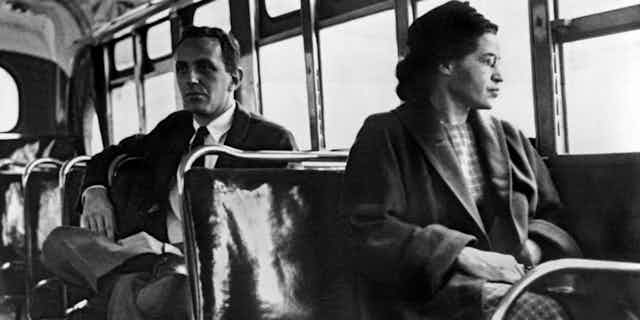Rosa Parks has gone down in history as an ordinary, elderly black woman who spontaneously kick-started the modern African American civil rights movement. It all began in December 1955, when Parks was arrested for civil disobedience: she had refused to give up her seat to a white passenger on a crowded bus in the racially segregated town of Montgomery, Alabama. Her defiance sparked the push for racial equality, which brought civil rights superstars such as Martin Luther King Jr into the public eye, and changed the world forever.
Or so the story goes. The truth – as is so often the case – is actually far more complicated.
In fact, Rosa Parks was just 42 years old when she took that famous ride on a City Lines bus in Montgomery – a town known for being the first capital of the pro-slavery Confederacy during the American Civil War. Parks – a seamstress at a downtown department store – had a history as a civil rights campaigner, having served as a youth organiser for the local branch of America’s oldest and most effective civil rights organisation, the National Association for the Advancement of Colored People (NAACP). She had also attended the controversial Highlander Folk School in Tennessee, where a number of African Americans were trained in protest methods by labour radicals.
Seizing the moment
Parks’ protest did not come out of the blue. In 1954, the US Supreme Court verdict in the case of Brown v Board of Education signalled federal opposition to racial segregation. The court ruled that segregated public schools deprived African Americans of their entitlement to “equal protection of the laws”. And black leaders in Montgomery – including labour activists, NAACP members, and middle-class members of the Women’s Political Committee – had been campaigning for better treatment for black people on the local buses for several years.
Parks’ refusal to give up her seat, and her subsequent arrest, seemed to offer these campaigners with the chance they had been looking for: to test the state’s bus segregation laws in the federal courts.

As soon as they heard of Parks’ arrest, Women’s Political Committee leader Jo Ann Robinson and veteran trade unionist E. D. Nixon set about mobilising a community-wide boycott of the buses. Under the leadership of a charismatic, but previously unknown preacher named Martin Luther King Jr, the Montgomery Improvement Association (MIA) spearheaded the year-long boycott that captured the attention of the world and heaped pressure on the city’s white authorities to respond to black demands.
Initially, the MIA used the African American response to Rosa Parks’ arrest to campaign for better treatment of blacks on the segregated buses. But the NAACP wanted more – it offered legal assistance to the MIA, on condition that the organisation fight for full integration.
To avoid legal complications relating to Parks’ arraignment, she was not made a plaintiff in the case of Browder v Gayle, which challenged Alabama’s segregation laws. In November 1956, the US Supreme Court issued a brief and narrow ruling that, in the wake of the Brown decision, racial segregation on private buses in Montgomery was unlawful under the Fourteenth Amendment.
A false dawn
This judicial success proved to be a false dawn for the civil rights movement in the United States. Martin Luther King and other prominent activists soon found that the Eisenhower administration had no intention of attacking racial segregation in the South with genuine vigour. Not until February 1960, when a group of black college students in Greensboro, North Carolina, initiated the first of what proved to be a rash of “sit-ins” in segregated stores, did the movement really gain momentum .
The nonviolent direct action protests that followed in cities such as Birmingham and Selma would eventually bring African Americans in the South an unprecedented degree of political and social power. The US civil rights movement also had a significant impact on racial protest in other parts of the world.

In Australia, students from the University of Sydney undertook their own “freedom ride” in 1965 to expose racism against the country’s indigenous inhabitants. Meanwhile, in the United Kingdom, it was an inspiration for the Bristol bus boycott of 1963 and the Northern Ireland civil rights demonstrations later in the decade.
Rosa Parks died in 2005. She earned her place in history, alongside hundreds of other brave men and women who helped end racial segregation by statute. Even today, the Black Lives Matter movement in the United States – sparked by the unlawful police killing of African Americans – demonstrates that the activist spirit unleashed in Montgomery in 1955 lives on.

